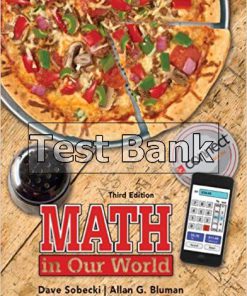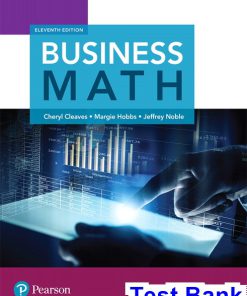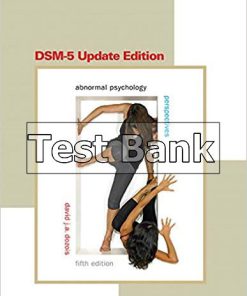Math Lit 1st Edition Almy Test Bank
You may also like
-
$26.50
$50.00 -
$26.50
$50.00 -
$26.50
$50.00 -
$26.50
$50.00 -
$26.50
$50.00
Instant download Math Lit 1st Edition Almy Test Bank pdf docx epub after payment.

Product Details:
- ISBN-10 : 0321818458
- ISBN-13 : 978-0321818454
- Author:
Table of contents:
CYCLE ZERO Which type of number?
SELF-ASSESSMENT: PREVIEW
0.1 If the World Were a Village: Focus Problem
0.2 Keeping It Real: Types of Numbers and Rounding
- Identify types of real numbers
- Round whole numbers
0.3 It’s All Relative: Integers and Their Operations
- Interpret integers
- Add, subtract, multiply, and divide integers
- Solve application problems involving integers
0.4 Part and Whole: Rational Numbers and Their Operations
- Interpret fractions
- Add, subtract, multiply, and divide fractions
IN THE NEWS: WHICH SPF IS BEST?
0.5 What’s the Point? Decimals and Their Operations
- Interpret decimals
- Round decimals
- Add, subtract, multiply, and divide decimals
0.6 On the Grid: Percent Representations and Calculations
- Convert between fractions, decimal values, and percents
- Calculate the base, amount, or percent in a percent problem
- Calculate percent change
Cycle 0 Study Sheet
Self-Assessment: Review
Cycle 0 Wrap-Up
CYCLE ONE Where do we start?
SELF-ASSESSMENT: PREVIEW
1.1 Understanding the Opioid Epidemic: Focus Problem
1.2 Getting Started: Reviewing Prealgebra
- Use Venn diagrams
- Solve applied problems involving fractions
1.3 Hello, My Name Is: Graphing Points
- Plot ordered pairs
- Determine the coordinates of a point
- Create and interpret line graphs
1.4 A Tale of Two Numbers: Ratios and Proportions
- Interpret ratios
- Scale ratios to produce equivalent ratios
- Determine if quantities are proportional
1.5 Chances Are: Probability Basics
- Find relative frequencies
- Find and interpret experimental probabilities
1.6 An Ounce of Prevention: Means
- Find and interpret the mean of a set of numbers
- Use means in applied problems
1.7 Picture This: Making and Interpreting Graphs
- Create and interpret pie graphs
- Create and interpret bar graphs
Mid-Cycle Recap
In the News: Understanding Infection and Mortality Rates
1.8 Two by Two: Scatterplots
- Create and interpret scatterplots
- Sketch a curve to best fit a scatterplot
1.9 Multiply vs. Divide: Converting Units
- Convert units by multiplying or dividing
1.10 Up and Down: Percent Change
- Apply a percent change
- Interpret percent change
1.11 The X Factor: Algebraic Terminology
- Differentiate between variables and constants
- Differentiate between expressions and equations
- Differentiate between factors and terms
1.12 General Number: Recognizing Patterns
- Make conjectures and generalize patterns
- Identify and use arithmetic and geometric sequences
1.13 Social Network: Linear and Exponential Change
- Model change with linear and exponential functions
1.14 Infinity and Beyond: Perimeter and Area
- Calculate perimeter and area
Cycle 1 Study Sheet
Self-Assessment: Review
Cycle 1 Wrap-Up
CYCLE TWO How does that work?
SELF-ASSESSMENT: PREVIEW
2.1 Genetic Probabilities: Focus Problem
2.2 Rule of Thumb: Weighted Means
- Find and interpret weighted means
- Find the median and mode of a data set
2.3 Measure Up: Basic Exponent Rules
- Apply basic exponent rules
- Use geometric formulas
2.4 Count Up: Adding Polynomials
- Identify and add like terms
2.5 A Winning Formula: Applying Order of Operations
- Use the order of operations to simplify expressions
- Evaluate formulas and expressions
2.6 Does Order Matter?: Rewriting Expressions
- Apply the commutative and associative properties
2.7 Fair Share: Distributive Property
- Apply the distributive property to expressions
- Use the distributive property in applied contexts
2.8 Seat Yourself: Equivalent Expressions
- Write an expression to represent a scenario
- Determine if two expressions are equivalent by using the commutative, associative, and distributive properties
2.9 Parts of Speech: Using Operations Correctly
- Distinguish between an operator and an object
- Determine the object on which an operator is acting
- Recognize when the distributive property can be applied
Mid-Cycle Recap
In the News: Misorder of Operations
2.10 A Fine Balance: Verifying Solutions
- Verify a solution to an equation
2.11 Back and Forth: Writing and
Solving One-Step Equations
- Write and solve one-step equations
2.12 Maintaining Balance: More Equation Solving
- Solve multi-step linear equations
2.13 Quarter Wing Night: Writing and Solving Equations
- Write an equation to model a situation
- Solve a problem numerically and algebraically
2.14 Outwit and Outlast: Using Proportions
- Write and solve proportions
2.15 Three of a Kind: Pythagorean Theorem
- Use the Pythagorean theorem to find the length of a side in a right triangle
- Solve problems using the Pythagorean theorem
2.16 What Are the Odds?: Theoretical Probability
- Calculate theoretical probabilities
- Compare theoretical and experimental probabilities
2.17 Size Up: Volume and Surface Area
- Calculate volume and surface area
Cycle 2 Study Sheet
Self-Assessment: Review
Cycle 2 Wrap-Up
CYCLE THREE When is it worth it?
SELF-ASSESSMENT: PREVIEW
3.1 Growing Money: Focus Problem
3.2 What’s Trending: Correlation
- Determine if data has a positive or negative linear correlation
- Graph the equation of the trendline
- Use the equation of the trendline to make predictions
3.3 Constant Change: Slope
- Find the slope of a line from points, tables, and graphs
- Find and interpret slope in applications
3.4 Shortest Path: Distance Formula
- Use the distance formula to find the distance between two points
3.5 Get in Line: Slope-Intercept Form
- Find and interpret the slope and y-intercept from a linear equation
- Graph a line using a table and using the slope and y-intercept
3.6 More or Less: Linear Relationships
- Solve problems using linear equations, tables, and graphs
3.7 Chain, Chain, Chain: Writing Linear Equations
- Write the equation of a line using a point and the slope
- Write the equation of a line using two points
- Create a linear model in an applied problem
3.8 Going Viral: Exponential Functions
- Write the equation of an exponential function using a starting value and rate of change
- Graph exponential functions
- Model with exponential functions
Mid-Cycle Recap 348
In the News: Misleading Headlines
3.9 Untangling the Knot: Solving Nonlinear Equations
- Solve nonlinear equations
3.10 Hot and Cold: Rewriting Formulas
- Solve an equation for a specified variable
3.11 A Common Goal: Greatest Common Factors
- Identify the greatest common factor for the terms in an expression
- Factor an expression using the greatest common factor
3.12 Thinking Outside the Box: Factoring Quadratic Expressions
- Factor quadratic expressions
3.13 A Formula for Success: The Quadratic Formula
- Use the quadratic formula to solve equations
3.14 The Turning Point: Quadratic Functions
- Identify a quadratic pattern in data
- Find the vertex of a parabola
3.15 Systematic Thinking: Graphing and Substitution
- Solve a 2 x 2 linear system of equations by graphing
- Solve a 2 x 2 linear system of equations by substitution
3.16 Opposites Attract: Elimination
- Solve a 2 x 2 linear system of equations by elimination
Cycle 3 Study Sheet
Self-Assessment: Review
Cycle 3 Wrap-Up
CYCLE FOUR What else can we do?
SELF-ASSESSMENT: PREVIEW
4.1 Scale Matters: Focus Problem
4.2 A Matter of Change: Dimensional Analysis
- Convert units using dimensional analysis
4.3 Little Giants: Scientific and Engineering Notation
- Convert numbers between scientific and standard notation
- Convert numbers into and out of engineering notation
4.4 A Model Approach: Negative Exponents
- Use exponent rules to simplify expressions that have negative exponents
4.5 Variation on a Theme: Standard Deviation
- Find the standard deviation of a data set
- Interpret the standard deviation of a data set
4.6 An Order of Magnitude: Understanding Logarithmic Scales
- Interpret and use order of magnitude
- Interpret and use logarithmic scales
Mid-Cycle Recap
In the News: Measuring Variation
4.7 Straight to the Point: Direct Variation
- Identify direct variation from a graph, table, or equation
- Write models for direct variation problems
- Solve direct variation problems
4.8 Gas Up and Go: Inverse Variation
- Identify inverse variation from a table or equation
- Write models for inverse variation problems
- Solve inverse variation problems
4.9 Ghost in the Machine: Function Notation
- Use function notation
- Find a function input or output given the other
4.10 What’s Your Function?: Vertical Line Test, Domain, and Range
- Apply the vertical line test
- Find the domain and range from a graph or an equation
4.11 An Important Point: Vertex Form of a Quadratic Function
- Identify the vertex of a quadratic function in vertex form
- Graph a quadratic function in vertex form
- Write the vertex form of a quadratic function given the vertex and a point
4.12 A Survey of Trig: Trigonometric Functions
- Write the six trigonometric ratios for an acute angle
- Use trigonometric functions to find the measures of sides and angles of a right triangle
People Also Search:
a root in math 7 little words
math lit break-even analysis
difference between math core and math lit
can you study business with math lit
careers with math lit












